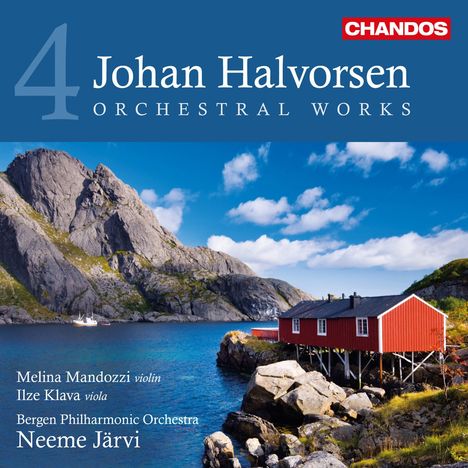Johan Halvorsen: Orchesterwerke Vol.4 auf CD
Orchesterwerke Vol.4
Herkömmliche CD, die mit allen CD-Playern und Computerlaufwerken, aber auch mit den meisten SACD- oder Multiplayern abspielbar ist.
Lassen Sie sich über unseren eCourier benachrichtigen, falls das Produkt bestellt werden kann.
Nordische Festouvertüre op. 16; Norwegische Rhapsodien Nr. 1 & 2; Norwegische Brautprozession; Tanzszene aus Königin Tamara; Symphonisches Intermezzo aus Der König; Norwegische Märchenbilder op. 37
+Passacaglia op. 20 Nr. 2 für Violine & Viola (nach Händel)
- Künstler:
- Melina Mandozzi, Ilze Klava, Bergen Philharmonic Orchestra, Neeme Järvi
- Label:
- Chandos
- Aufnahmejahr ca.:
- 2011
- UPC/EAN:
- 0095115171028
- Erscheinungstermin:
- 1.4.2012
Dass Norwegen musikalisch mehr zu bieten hat als Grieg und die Popgroup a-ha beweisen Neeme Järvi und das Bergen Philharmonic Orchestra eindrucksvoll mit ihrer jetzt abgeschlossenen Gesamteinspielung der Orchesterwerke von Johan Halvorsen (1864-1935), in denen der Komponist die national-romantische Musiktradition Griegs mit eigenen, originellen Mitteln erfolgreich fortführt. Nordische Spätromantik vom Allerfeinsten!
Product Information
This is the fourth and final volume of colourful and highly appealing orchestral works by the Norwegian composer Johan Halvorsen.
Based on the Passacaille (Chaconne) from the Harpsichord Suite No. 7 in G minor by Handel, Halvorsen’s Passacaglia is a virtuosic duo for solo violin and viola, later made world famous by artists such as Leopold Auer and Jascha Heifetz. It starts as a simple arrangement of Handel’s original score, but after the presentation of the theme and the first three variations it gradually differs more and more, until it finally frees itself entirely from the original and becomes pure ‘Halvorsen’.
Halvorsen wrote extensively for the stage, and his lifelong fascination with ‘exotic’ elements in music is evident in the ‘Dance Scene’ from the incidental music to Knut Hamsun’s Queen Tamara, a historical play set in the Caucasus. In contrast, the Symphonic Intermezzo from the music to Bjørnstjerne Bjørnson’s The King is presented in the form of a tone poem, its language strongly influenced by the musical universe of Liszt and Wagner.
Also on this disc is Halvorsen’s orchestration of Grieg’s piano piece Norwegian Bridal Procession. Other orchestral versions exist, among others by Frederick Delius, but in Grieg’s eyes only a native Norwegian could portray rural Norway in music without becoming too romantic or picturesque. Halvorsen’s lush, but non-idealising orchestration proved an immediate success, and at concerts and in the theatre over the next twenty-six years Halvorsen conducted the work at least 140 times.
He considered his Norwegian Fairy Tale Pictures to be one of his best works. The suite is vividly programmatic, drawn from music that he had written for a children’s comedy: violins portray the fairy tale hero, the flute plays the part of the abducted princess, while the villainous troll is represented by a motif in the bass.
Disk 1 von 1 (CD)
-
1 Rhapsodie norvégienne Nr. 1
-
2 Rhapsodie norvégienne Nr. 2
Szenen aus dem Volksleben op. 19 Nr. 1-3 (Humoresken) (bearb. für Orchester) (Auszug)
-
3 Nr. 2: Brudefolget drager forbi
-
4 Passacaglia op. 20 Nr. 2 (nach Georg Friedrich Händels Suite für Cembalo I Nr. 7 g-moll HWV 432)
-
5 Dance scene (nach Knut Hamsuns Queen Tamara)
-
6 Symphonic intermezzo from "The King" (nach Bjornstjerne Bjornsons Music op. 19 to the Play Kongen)
-
7 Norsk festouverture (für Orchester)
Norske eventybilleder op. 37 (Suite from the Play Peik og Stortroldet by Adam Hiorth)
-
8 1. Peik, princessen og stortroldet -
-
9 Troldmoernes dans
-
10 2. Prinsessen kommer ridende på Bjornen
-
11 3. Troldenes indtog i Berget det blå
-
12 4. Dans av Småtrold






